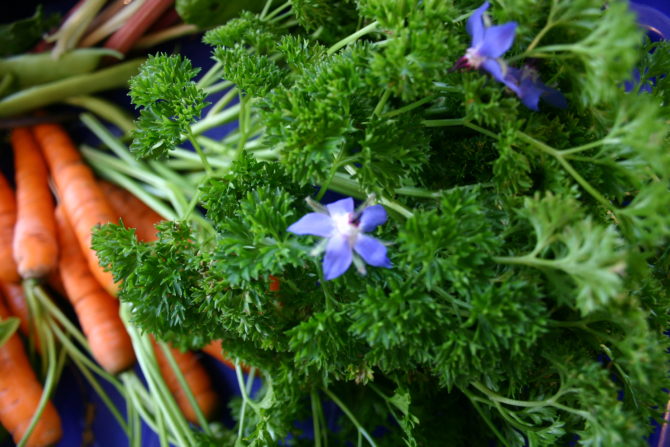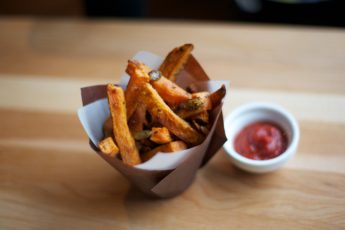Happy Herb Week!
This week we’re breaking down the how and why you should be growing fresh herbs in your kitchen or garden!
Why are Herbs good for me?
Adding herbs to your diet can make a remarkable impact on your health. Herbs are nutrient-dense meaning that they are low in calories and provide nutrients for the body. These strong little plants contain antioxidants, vitamins, minerals, dietary fibre, essential oils, anti-bacterial, and anti-inflammatory properties.
What are the health benefits of herbs and how can I grow them myself?
It is beneficial to grow your own herbs if possible. It sounds like it would take a lot of work and care, but most of the herbs only need watering every few days. Herbs will not only help to make your food taste better, but you will also gain many health benefits. Growing your own herbs will increase the flavor of your fresh herbs and they are richer in vital vitamins and anti-oxidants than herbs you purchase.
There are numerous easy ways to include herbs in your diet, such as adding them to your salad dressing, sauces, stews, dip, and vegetable dishes.
1. Cilantro
Cilantro is an ancient and popular herb that has been used since Egyptian times. Individuals will either love cilantro or absolutely hate cilantro; for the latter even a tiny amount can ruin a dish. It has an aniselike taste and an earthy, fetid aroma. A small amount will enhance the flavor and taste of dishes. Cilantro has many health benefits including lowering ‘bad’ LDL cholesterol while increasing ‘good’ HDL cholesterol. Cilantro also regulates energy, aids digestion, and relieves intestinal gas, pain, and distention. Cilantro is a good source of Vitamin C and an excellent source of Vitamin A. Vitamin C increases your immune system while Vitamin A helps to maintain healthy skin and eyes.
Grow your own!: Cilantro grows best in the late spring, between the months of March and May. In order to grow, cilantro requires full sun exposure and should be watered frequently (1 inch of water per week).
2. Dandelion
Although dandelions are unwanted squatters on lawns and byways and herbicides are used to get them removed, they won’t disappear, so you might as well spare the environment and reap their health benefits!
Dandelion leaves can be used to replace spinach in a salad. The leaves also make a great tea that has many health benefits for your body to take advantage of and is great for digestion and it’s ability to stimulate liver function and reduce inflammation. Dandelions are nutrient-dense and a great source of Vitamin A, potassium, as well as calcium. For non-dairy consumers, it is a great alternative for meeting your calcium requirements.
Grow your own!: Dandelions require full sun exposure. Harvest leaves while they are young as they will be less bitter.
3. Parsley
Parsley is the world’s most popular herb, which is also a biennial plant meaning it will grow for more than one season after it is first planted. Parsley can be used in vegetable dishes, as a base for salad dressings, or put a large amount in stews or casseroles. Parsley helps with digestion that also detoxifies the body by flushing out fluid from the body and therefore supporting kidney function. It assists in stimulating the bowels, and helps prevent hypertension as it controls blood pressure. The essential oil Eugonol in parsley treats tooth and gum diseases, and controls blood sugar levels, which makes it great for people with diabetes. Out of all the herbs it is the richest in vitamin K, which aids in bone health by helping to build bone mass and is thought to be protective against Alzheimer’s disease by limiting the neuronal damage in the brain.
Grow your own!: Parsley requires partial sunlight to grow and can be grown indoors next to the windowsill or outside. It should be watered at least once a week and planted in the early spring. Start to harvest once three leaves are developed.
4. Basil
Basil is a common herb with a sweet and earthy aroma when fresh and combines well with many other herbs. It is most commonly used in pesto but basil has over 50 varieties including sweet, bush, and purple type. Basil is beneficial for individuals who have lung- or stomach-related complaints and can also be used to treat mild depression, anxiety, headache, or menstrual pain.
Grow your own!: Basil is extremely easy to grow and it grows inside or outside. It only needs to be watered every few days. A few leaves go a long way and the stems can be great for flavouring broths.
5. Sage
Sage is peppery in taste and treats the consequences of aging. It is a memory enhancer, and mild Alzheimer’s sufferers will benefit from this herb. Sage lowers cholesterol and triglyceride levels as it contains a substantial amount of Rosmarinic acid, which is an anti-inflammatory, and antioxidant. It can also be used to prevent hot flashes in menopausal women.
Grow your own!: Sage grows easily and does not require a lot of care or fuss. This herb should only be watered when the soil is dry and should ideally be in sunlight but will tolerate warm shade. In the first year it grows remove only the leaves when harvesting and in subsequent years the stems can also be used.
Fresh herbs are addictive and once yours are flourishing you will love adding a little spark to all your home cooking with these babies!
If you’re looking for ideas on how to get immersed in the kitchen using these herbs to create delicious, satisfying recipes look no further than our upcoming Fresh in Four series where we make signature Fresh dishes that you can recreate in your home!


